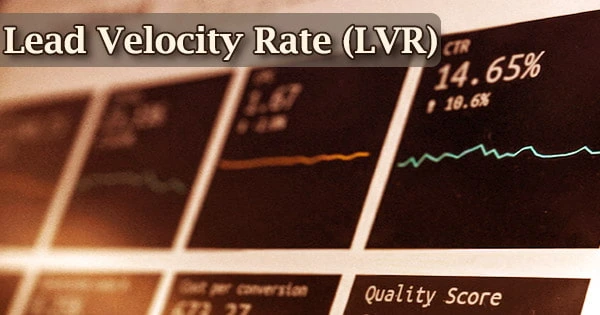The lead velocity rate (LVR) is a measure that indicates how rapidly qualified leads progress through the sales funnel and become clients. LVR is a metric that measures the percentage change in qualified leads from one month to the next. LVR can be a powerful predictor of the business’s revenue and growth trajectory when assessed month to month.
A qualified lead (also known as a marketing qualified lead) is a potential consumer who has expressed interest in buying a company’s product or service and has passed a series of lead requirements. Understanding the difference between unqualified and qualified leads is crucial to grasping the idea of lead velocity rate.
Essentially, the lead velocity rate measures the month-to-month percentage change in the quantity of qualified leads to determine your company’s long-term growth potential. LVR allows you to forecast sales from month to month by implementing a strategy for systematically qualifying leads.
The lead velocity rate (LVR) is a metric that assesses how efficient and productive a company’s sales funnel is. LVR provides a solid platform for more precise growth and scalability projections and planning, reducing the need for “guesstimating.” This is true even for businesses that rely on recurring revenue, such as subscription-based software as a service (SaaS) businesses.
One of the most important key performance indicators (KPIs) for SaaS companies is the LVR. It’s usually used to compare the number of qualifying leads generated in the current month to the prior month (though it is also useful to reference versus the same period last year or 6 months previously to determine trajectory).
Lead velocity rate is commonly used by businesses to evaluate the efficiency of their sales as well as their growth potential. LVR, on the other hand, is “real-time, not trailing,” and “clearly forecasts your future sales and growth.” As a result, it is a more strategic statistic than sales growth.
LVR is a good metric of corporate sales growth because it exclusively tracks qualified leads. A greater LVR shows that a corporation is making good use of its sales and marketing resources. When the LVR falls over time, on the other hand, it’s a sign that the company isn’t reaching its full potential.
It’s critical to distinguish between Lead Velocity Rate (LVR) and Sales Velocity Rate (SVR). It examines characteristics such as the number of deals, average deal size, win rate, and sales cycle time rather than growth or shrinkage. You can expect your LVR to raise sales by a similar percentage, and if it doesn’t, it’s a sign that something has to be tweaked.
A sales rate that is out of sync with your LVR suggests one of two issues with your company: either a sales team that needs to improve or a product problem that is keeping sales from being as robust as they should be.
How to calculate Lead Velocity Rate (LVR) –
The current month’s lead velocity rate (LVR) is determined as a percentage change in the number of qualifying leads compared to the previous month. LVR can be calculated using the following formula:

While Lead Velocity Rate is a good predictor of performance and growth, it may not be sufficient to account for overall sales performance. It’s critical to get this metric’s “qualified lead” element right. A qualified lead is any prospect who has shown interest in your business and taken certain qualifying steps, such as filling out a form or clicking a link.
Most businesses have different definitions, but in a nutshell, a qualified lead is any prospect who has shown interest in your business and taken certain qualifying steps, such as filling out a form or clicking a link.
The lead velocity rate (LVR) is a better measure of actual sales growth than revenue, according to proponents. The reason for this is that lead velocity rate is a live, in-the-moment metric. As a result, the company’s management can forecast the trajectory of its sales growth using this statistic.
LVR may also identify quick changes that a company has to do in order to improve its sales success. It’s usually measured with other revenue measures to put the sales team’s success in context. LVR is unquestionably a great performance statistic when it comes to marketing, sales, and lead creation.
Using the LVR instead of sales revenue can be a better indication of real-time growth, especially when comparing month-to-month figures. A company’s sales growth trajectory can be predicted using the LVR.
The Lead Velocity Rate differs greatly depending on the industry, product type, and target market. While an increase is definitely promising, it is unclear how many of those qualified leads result in actual sales or money. Although LVR is most commonly used for month-to-month lead tracking, it can also be employed over a longer period of time.
However, the LVR’s main flaw is that it does not take into account actual sales. Although LVR gives us an idea of how well a business can grow the quantity of qualified leads, it doesn’t tell us how well those qualified leads are turned into actual sales and money.
When the LVR and sales process are out of sync, the measure loses its validity and becomes more effective as a way of pointing out a problem rather than as a gauge of your company’s progress. LVR is commonly used in conjunction with other profitability indicators, such as monthly recurring revenue (MRR). LVR and MRR together can be a powerful and revealing tool.
LVR must be combined with a consistent sales conversion rate or velocity across the sales funnel in order to accurately represent performance. A corporation can highlight changes in strategy and evaluate whether they translated into customer growth over time by comparing the LVR from one year to the next.
















